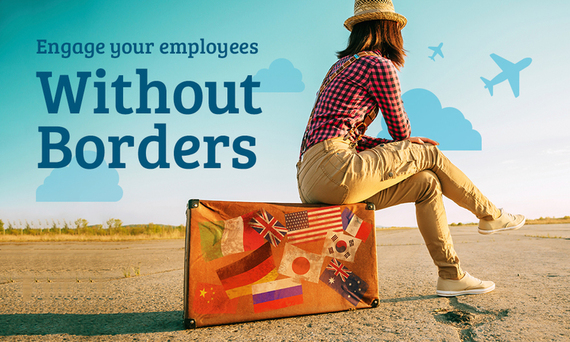Many believe that the relentless pursuit to offer the next compelling employee benefit that will attract and retain the talent companies need is a "race to the bottom." But there's a gem sitting right in front of us that is shinier than any trendy perk. Hint: it's not free yoga classes, the drink fridge or bring-your-dog-to-work Fridays. It's the idea of delivering up Goodness as part of the employee experience, which is even more powerful in a global context, as businesses continue to be challenged to create a unified corporate culture that transcends borders and leverages diversity.
Goodness, expressed through the giving of time, money, talent and services to worthy charities via the workplace, is a proven way to engage your people while solidifying your brand and reputation to an even wider audience.
Employee giving and volunteering is simply one of the best - and most underutilized - workplace benefits to unite global employees. It springs from within employees themselves, their intrinsic desire to make a positive social impact and the power in bringing meaning and purpose to one's work. By shifting the focus towards Goodness, local and international businesses can transform cultural challenges into ripe opportunities for building a truly engaged and inclusive workforce.
Global companies like Microsoft, Google and Nike are already starting to figure this out, as international giving among multinationals like these is on the rise. Companies expect international giving rates to increase by 25 percent over the next two years, according to a recent study from the Boston College Center for Corporate Citizenship.
We've heard from employees at Fortune 1000 companies that they want a chance to give, volunteer and get involved in their company's philanthropic efforts anywhere around the world. But this has proven difficult or even impossible for corporate responsibility and benefits managers who have tended to provide only U.S. or North American-centric programs. Doing it right (accounting for nuances like language, currency, domestically relevant charity validation, global payment disbursement to charities and more) is complex. It requires a single platform that unites functions and purposes into one experience under the company's brand; it's about being global and local at the same time.
Until recently, it was a struggle to deliver a similar experience to all your people. But with better solutions now available, and a knowledge of geographic nuances, companies can invest in international Goodness efforts that will shape a more unified global workforce. Here are three key reasons why you should do it:
1. It's One Thing Boomers, Millennials and Generation Z Can Agree On
Companies have spent a lot of time thinking about how to cater to Millennials, but this summer an even younger cohort has begun to enter the labor force. The eldest of those born between the 1990s and early 2000s - dubbed "Generation Z" - have graduated college and are becoming your workmates.
Like their Millennial predecessors, Gen Z wants to integrate work with life, and do Good in the world. This group tends to prefer a career that gives them a chance to help people, according to a study of 49,000 members of Gen Z across 47 countries. You can bet these employees will be attracted to - and stick with - employers that value volunteerism and philanthropy anywhere in the world.
This aligns strongly with not only the demands of Millennials but Boomers, too, who are not all that different from the generations that followed them (at least in this sense). Across the board, the employees of the present and the future want to work for companies that provide a sense of greater purpose and support them in living the values to which they aspire.
2. It Helps Make Inclusion More than an HR Buzzword
For international program expansion to be successful, companies need to tackle diversity and inclusion amidst evolving workplace demographics. As companies cross borders, they often can't easily anticipate the nuances of employee needs in offices outside of headquarters. By creating consistent employee engagement benefits across all locations, people can rally around a single experience and build closer relationships with each other. Having a prosocial culture shows your people and other stakeholders what your company universally stands for in more than a lip-service way. Employees, whether they want to give to causes in their backyard or halfway around the world, need a trusted, convenient and tech-savvy way to support their organization(s) of choice. For example, an employee in Beijing may want to donate part of her paycheck to a local Chinese charity. She will need her company to invest in technology that supports the right currency and language, and ensures the company's eligibility criteria have been met. Employee giving and engagement - and the technology that backs the program - needs to be flexible, adaptable and global.
3. It's Good for the Bottom Line
Successful employee engagement strategies are one of the greatest opportunities available to all companies, and there are numerous studies showing unequivocally that active and engaged employees improve the bottom line. Companies with well-designed corporate responsibility programs can reduce employee turnover by 50 percent and increase employee productivity by 13 percent, according to a report published by Project ROI last year. Furthermore, investing in global Goodness programs can help companies empower their employees to achieve smoother operations in global markets, bolster community relationships internationally and improve their reputation with employees and customers outside corporate headquarter countries.
To create solid engagement programs, companies need the technology and tools to scale workplace giving, volunteerism and grantmaking so that all employees feel invested, whether they are in Palo Alto or Paris. The key is providing a globally consistent experience that resonates at a local level, connecting individuals personally while knowing the impact may be felt a world away.
As the business climate becomes more competitive, a global approach to international giving -- delivered with a local experience -- helps employees both inside and outside of headquarters feel heard and valued, while fueling their passions at work.
